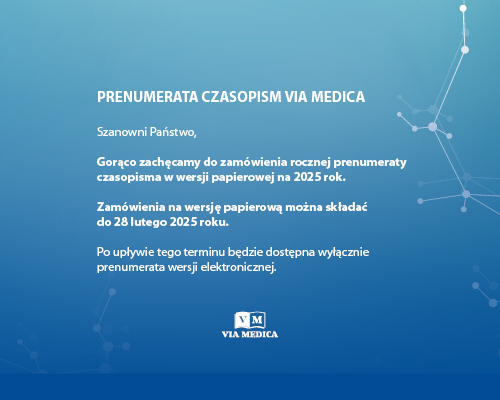Uszkodzenie błon komórkowych jako cel interwencji terapeutycznej w procesach neurozwyrodnieniowych — miejsce citikoliny
Streszczenie
Rozpad błon komórkowych jest charakterystyczną cechą i końcowym etapem neurozwyrodnienia, zarówno przebiegającego ostro (np. uraz i udar mózgu), jak i przewlekle (np. choroba Parkinsona czy choroba Alzheimera [AD, Alzheimer disease]). W ostatnich latach przeprowadzono wiele badań doświadczalnych i klinicznych, w których analizowano zmiany stężeń fosfolipidów zawierających cholinę, będących wskaźnikiem uszkodzenia błon komórkowych neuronów. Wykazano, że takie procesy patologiczne, jak uwalnianie glutaminianu, napływ wapnia do komórki oraz aktywacja fosfolipa- zy A2, stanowią istotne etapy kaskady zmian prowadzących do rozpadu błon komórkowych w warunkach niedotlenienia i niedokrwienia. W badaniach spektroskopii rezonansu magnetycznego wskazano wzrost związków zawierających cholinę w mózgach pacjentów z AD i z innymi chorobami neurozwyrodnieniowymi. Stwierdzenie, że cholina była czynnikiem regulującym szybkość biosyntezy fosfolipidów, stało się podstawą do dalszych badań klinicznych mających na celu przeciwdziałanie rozpadowi fosfolipidów, między innymi przez podawanie choliny i cytydyny. Prezentowany artykuł przedstawia aktualne dane dotyczące terapeutycznego działania citikoliny, ukierunkowanego na odbudowę integralności błon komórkowych, oparte na badaniach klinicznych u pacjentów z różnymi schorzeniami neurozwyrodnieniowymi.
Słowa kluczowe: błony komórkoweneurozwyrodnieniecytykolina
Referencje
- Watkins JC, Krogsgaard-Larsen P, Honoré T. Structure-activity relationships in the development of excitatory amino acid receptor agonists and competitive antagonists. Trends Pharmacol Sci. 1990; 11(1): 25–33.
- Doble A, Boireau A, Malgouris C, et al. Excitatory amino acid receptors and neurodegeneration. Therapie. 1995; 50(4): 319–337.
- Traynelis SF, Wollmuth LP, McBain CJ, et al. Glutamate receptor ion channels: structure, regulation, and function. Pharmacol Rev. 2010; 62(3): 405–496.
- Mayer ML, Armstrong N. Structure and function of glutamate receptor ion channels. Annu Rev Physiol. 2004; 66: 161–181.
- Faden AI, Demediuk P, Panter SS, et al. The role of excitatory amino acids and NMDA receptors in traumatic brain injury. Science. 1989; 244(4906): 798–800.
- van Meer G, Lisman Q. Sphingolipid transport: rafts and translocators. J Biol Chem. 2002; 277(29): 25855–25858.
- Hannun YA, Obeid LM. The ceramide-centric universe of lipid-mediated cell regulation: stress encounters of the lipid kind. J Biol Chem. 2002; 277(29): 25847–25850.
- Hannun YA, Obeid LM. Principles of bioactive lipid signalling: lessons from sphingolipids. Nat Rev Mol Cell Biol. 2008; 9(2): 139–150.
- Spiegel S, Milstien S. Sphingosine 1-phosphate, a key cell signaling molecule. J Biol Chem. 2002; 277(29): 25851–25854.
- Klein J. Membrane breakdown in acute and chronic neurodegeneration: focus on choline-containing phospholipids. J Neural Transm (Vienna). 2000; 107(8-9): 1027–1063.
- Gibellini F, Smith TK. The Kennedy pathway — de novo synthesis of phosphatidylethanolamine and phosphatidylcholine. IUBMB Life. 2010; 62(6): 414–428.
- Adibhatla R, Hatcher JF. Cytidine 5'-diphosphocholine (CDP-choline) in stroke and 6ther CNS disorders. Neurochemical Research. 2005; 30(1): 15–23.
- Conant R, Schauss AG. Therapeutic applications of citicoline for stroke and cognitive dysfunction in the elderly: a review of the literature. Altern Med Rev. 2004; 9(1): 17–31.
- Rejdak R, Toczołowski J, Solski J, et al. Citicoline treatment increases retinal dopamine content in rabbits. Ophthalmic Res. 2002; 34(3): 146–149.
- Wignall ND, Brown ES. Citicoline in addictive disorders: a review of the literature. Am J Drug Alcohol Abuse. 2014; 40(4): 262–268.
- Kowal P. Zastosowanie cytykoliny w chorobach układu nerwowego. Pol Przegl Neurol. 2016; 12(1): 42–45.
- Manaka S, Sano K, Fuchinoue T, et al. Mechanism of action CDP-choline in parkinsonism. Experientia. 1974; 30(2): 179–180.
- Hashihira S, Nishii T, Mori R, et al. CDP-choline as a drug for pancreatitis. Bull Osaka Med Sch. 1974; 20(1): 19–25.
- Secades JJ, Frontera G. CDP-choline: pharmacological and clinical review. Methods Find Exp Clin Pharmacol. 1995; 17 Suppl B: 1–54.
- Schauss AG, Somfai-Relle S, Financsek I, et al. Single- and repeated-dose oral toxicity studies of citicoline free-base (choline cytidine 5'-pyrophosphate) in Sprague-Dawley rats. Int J Toxicol. 2009; 28(6): 479–487.
- Fioravanti M, Yanagi M. Cytidinediphosphocholine (CDP choline) for cognitive and behavioural disturbances associated with chronic cerebral disorders in the elderly. Cochrane Database Syst Rev. 2004(2): CD000269.
- Putignano S, Gareri P, Castagna A, et al. Retrospective and observational study to assess the efficacy of citicoline in elderly patients suffering from stupor related to complex geriatric syndrome. Clin Interv Aging. 2012; 7: 113–118.
- Gareri P, Castagna A, Cotroneo AM, et al. The citicholinage study: citicoline plus cholinesterase inhibitors in aged patients affected with Alzheimer's disease study. J Alzheimers Dis. 2017; 56(2): 557–565.
- Qureshi I, Endres R. Citicoline: a novel therapeutic agent with neuroprotective, neuromodulatory, and neuroregenerative properties. Nat Med J. 2010; 2: 11–25.
- Bruce SE. Improvements in quantitative EEG following consumption of a natural citicoline-enhanced beverage. Int J Food Sci Nutr. 2012; 63(4): 421–425.
- Bruce SE, Werner KB, Preston BF, et al. Improvements in concentration, working memory and sustained attention following consumption of a natural citicoline-caffeine beverage. Int J Food Sci Nutr. 2014; 65(8): 1003–1007.
- Silveri MM, Dikan J, Ross AJ, et al. Citicoline enhances frontal lobe bioenergetics as measured by phosphorus magnetic resonance spectroscopy. NMR Biomed. 2008; 21(10): 1066–1075.
- Babb SM, Wald LL, Cohen BM, et al. Chronic citicoline increases phosphodiesters in the brains of healthy older subjects: an in vivo phosphorus magnetic resonance spectroscopy study. Psychopharmacology (Berl). 2002; 161(3): 248–254.



